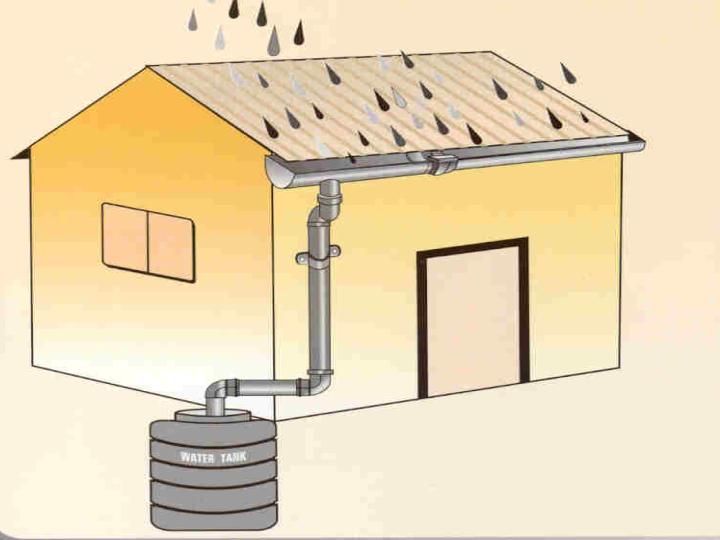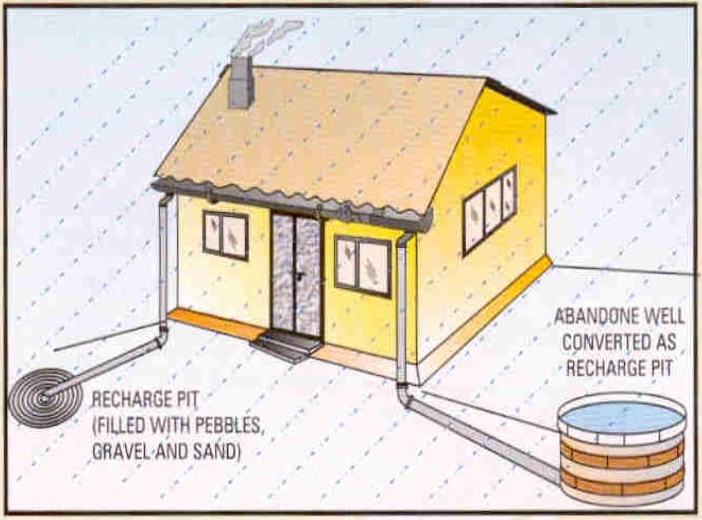|
1. Basics of Rainwater Harvesting
Introduction
Water is one of the most
commonly used substances on our earth. We need water for all our
activities in day-to-day life. Water supply in urban area is always short
against the total demand. Surface water is inadequate to meet our demand
and we have to depend on ground water. Due to rapid urbanization,
infiltration of rainwater into the subsoil has decreased drastically and
recharging of ground water has diminished. This scenario requires an
alternative source to bridge the gap between demand and supply. Rainwater,
which is easily available and is the purest form of water, would be an
immediate source to augment the existing water supply by "catching water
wherever it falls".
Rainwater Harvesting has
emerged as a viable alternative to traditional perennial sources of water
in hilly areas, in places where the level of fluoride and arsenic is above
permissible limits and in urban areas facing water shortage and flooding
during monsoons.
Rainwater Harvesting (RWH)
is the process of collecting and storing rainwater in a scientific and
controlled manner for future use. Rainwater Harvesting in urban areas
include
-
Roof top rainwater
harvesting
-
Rainwater harvesting in paved and un-paved areas (open fields, parks,
pavement landscapes etc.)
-
Rainwater Harvesting in
large areas with open ponds, lakes, tanks etc.
Benefits of Rainwater
Harvesting
-
Environment friendly and
easy approach for water requirements
-
RWH is an ideal solution for water requirements in areas having
inadequate water resources
-
Increases ground water level
-
Improves ground water quality
-
Mitigates the effects of drought
-
Reduces the runoff, which other wise flood storm water drains
-
Reduces flooding of roads and low-lying areas
-
Reduces soil erosion
-
Cost effective and easy to maintain
-
Reduces water and
electricity bills
Rainwater Harvesting
-
Traditional Water
Harvesting in Karnataka underlines the importance of step wells, lakes,
tanks, channels etc., as water storage bodies, the basic purpose of
which was to establish a chain of water storage structures. However, a
vanishing "Lake Culture" due to urbanization and industrialization has
caused these systems to be neglected.
-
To make Rainwater
Harvesting (RWH) a success, we should have a thorough knowledge of the
following:
geographic location; climate; geology; soil; land use; water
requirements; existing water supply system; cost of water; systems &
forms of RWH and the potential of harvesting rainwater.
-
RWH has the following
unique advantages
-
Capturing rainwater
in-situ and augmenting supply water at a marginal cost
-
Replenishing groundwater
through recharging of rainwater by using the soil column
-
Reducing pollution and
contamination
-
Reducing the water bill
for the state exchequer
-
Providing clean and safe
water
-
Least capital investment
with maximum benefits to households and the city as a whole
-
The demerits of RWH
-
It is dependent on the
monsoons and intensity of rainfall.
-
It depends on intensive
participation from house level to the city level.
-
It is only a
supplementary source and cannot replace the existing supply system
completely.
Quality of rainwater harvested
As the primary source of water, rainwater is the purest form of water.
Rainwater harvesting not only solves the problem of availability of
water, but also provides good quality water.
However, certain precautions need to be taken to ensure that the
stored water is not polluted.
-
Keep the roof or the
water collection area clean before the rains.
-
Flush the rainwater
collected in the first few minutes.
-
Store the collected
rainwater in a closed container (avoid sunlight).
-
The quality of water
deteriorates in the presence of sunlight and air.
-
Water can be kept clean
over a period of five to six months in a clean container stored in an
enclosed area protected from sunlight.
Who can harvest rainwater and where?
-
People planning construction of house, modification of house, existing
house, etc.
-
From rooftops of Govt. buildings, Institutions, Hospitals, Hotels,
shopping malls etc.
-
From rooftops and open areas
-
Farmlands, Public Parks, Playground, etc.
-
Paved and unpaved areas of a layout/city/town/village
Need for rainwater harvesting
Water harvesting is an activity of collection of rainwater and storing
in containers for direct use or can be recharged in to the ground.
-
As water is becoming
scarce, it is the need of the day to attain self-sufficiency to
fulfill the water needs
-
As urban water supply
system is under tremendous pressure for supplying water to ever
increasing population
-
Groundwater is getting
depleted and polluted
-
Soil erosion resulting
from the unchecked runoff
-
Health hazards due to
consumption of polluted water
Methods
Rainwater Harvesting
Rainwater stored for direct use in tanks above ground or underground
sumps or overhead tanks and used directly for flushing, gardening,
washing etc.
Ground water recharge
Recharged to ground through recharge pits, dug wells, bore wells, soak
pits, recharge trenches, etc.
Rainwater Harvesting potential
Rainwater harvesting potential in urban areas is huge. Considering the
availability of rainwater in a residential site of 40 x 60 feet (an area
of 2400sq.ft./223 sq.mts.), around 2,23,000 lts of rainwater can be
harvested in a location where the rainfall is around 1000 mm or 39.4
inches (Bangalore receives around 1000 mm of rainfall annually). The
amount of rainwater that can be harvested from the available rainwater
in the plot depends on potential rainfall, catchment area available,
collection methods and its efficiency etc.
Rainwater Harvesting for Domestic Applications
Water requirement of a house can be broadly classified into
-
Drinking
-
Cooking
-
Bathing
-
Washing
-
Vehicles
-
Utensils
-
Clothes
-
Floor cleaning
-
Gardening
-
Flushing in toilets
For washing, gardening and flushing toilets, relatively less clean
water can be used (secondary use).
Rainwater Harvesting (RWH) can meet all these above needs with
suitable RWH techniques.
Water requirement in a house is throughout the year. However,
rainwater availability without having facilities to store is limited
to number of rainy days and the quantity of rainwater available during
the rainy days. Several interventions can be made to enhance the
number of days of use of rainwater from number of rainy days to 365
days a year. Parameters, which support rainwater harvesting, are
availability of space, willingness to invest, technical suitability of
soil structure and geological parameters.
|
The text and images used in this webpage are taken from the
book
"Amruthavarshini - A guide for Rainwater Harvesting"
published by Karnataka State Council for Science and Technology.
|
Go
Top
|


